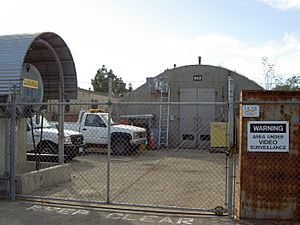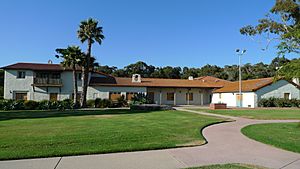History of the University of California, Santa Barbara facts for kids
The University of California, Santa Barbara (UCSB) is a famous university in California. Its history goes way back to the 1800s! It started from the Santa Barbara School District, which began in 1866. UCSB's very first version was called the Anna S. C. Blake Manual Training School. It was named after Anna S. C. Blake and opened in 1891. This school taught practical skills. Over the years, the school changed a lot, and in 1944, it became part of the big University of California system.
Early School Days
Anna S. C. Blake started her Manual Training School in 1891. Here, students learned useful skills like cooking (home economics) and working with tools (industrial arts). Anna Blake based her teaching on the "sloyd method," which was a special way to teach hands-on skills. She sent her neighbor, Ednah Rich, to learn this method in places like Boston, Sweden, and Germany. Ednah Rich became the school's principal in 1896.
In 1898, Anna Blake gave her school to the city of Santa Barbara, California. It became part of the public school system. The official transfer happened on July 1, 1899, shortly after Anna Blake passed away.
In 1909, the state took over the Anna Blake School. It was renamed the Santa Barbara State Normal School of Manual Art and Home Economics. The campus was in a beautiful area called the Riviera in Santa Barbara. Some parts of that area are now home to the Riviera Theatre. By 1913, houses were built nearby for teachers and students.
In 1921, the school changed its name again to Santa Barbara State Teachers College. It started offering more subjects, not just teaching. It also began giving out four-year college degrees. Then, in 1935, it became the Santa Barbara State College. This new name showed that it offered even more types of learning in both teaching and other subjects.
The college grew very quickly and needed a new campus. After a big earthquake in Santa Barbara in 1925, a large piece of land became available. This land was bought for the college by 1932. The first new building on this land was finished in 1941.
Joining the University of California
A group of people in Santa Barbara, led by Thomas M. Storke and Pearl Chase, worked very hard. They convinced the state government, Governor Earl Warren, and the main leaders of the University of California (called the Regents) to move the State College into the University of California system in 1944. The State College system tried to stop this, but the Governor didn't support them.
However, people in the state later voted for a special rule. This rule stopped other State Colleges from joining the University of California system in the future. From 1944 to 1958, the school was known as Santa Barbara College of the University of California. After that, it got its current name, UCSB.
At first, the University of California leaders imagined UCSB as a small college for a few thousand students. It would focus on general subjects, like a "Williams College of the West." UCSB was the third general-education campus to join the University of California system. The first two were Berkeley and UCLA.
The first campus the Regents got in Santa Barbara was only about 100 acres (40 ha) big. Much of this land wasn't very useful. But then, they found a 400-acre (160 ha) piece of land in Goleta, California. This land used to be a military air station until 1946. The federal government offered it to the Regents for free! So, in 1949, this became the new Santa Barbara campus.
Vernon Cheadle was the leader (chancellor) of UCSB from 1962 to 1977. He helped make the college stable and strong. He also helped turn the state college into a major research university, just as people like Storke had hoped for.
Since the year 2000, professors at UCSB have won five Nobel Prizes. This has made the university's academic reputation even stronger.
Campus Growth
The UCSB campus has grown by buying land nearby. This includes a large part of a ranch that belonged to the Powys Campbell family. UCSB's West Campus now has a child care center, university stables, and housing for professors.
The university bought 221.5 acres (89.6 ha) of land from the Devereux Foundation in 1967. They also got the first chance to buy the remaining 33 acres (13 ha), which they did in 2007. Some of this land, along the ocean bluffs and an open field, was set aside permanently as a nature preserve.
The Campbell ranch was bought and developed starting in 1919 by Colonel Powys Campbell and his wife Nancy Leiter Campbell. This land was once part of a very old Mexican land grant from the 1840s. The 500-acre Campbell Ranch was a very important property. It was one of the biggest in Santa Barbara County. The family owned it until after World War II. A large part of it was bought by Helena T. Devereux in 1945. She built a special school there. The University of California bought the last 33 acres (13 ha) in 2007. You can still see parts of the Campbell family's history, like a Celtic cross and an old redwood barn near the university stables.
In 2003, the university bought some private dormitories. These dorms are now called the Santa Catalina Residence Halls and house UCSB students. In early 2015, the university started making these residence halls even bigger.
Providing affordable homes for professors was important to attract and keep good teachers. In 1986, 65 housing units for professors were finished at West Campus Point. The university sells these homes to qualified professors at a special price. When a professor wants to sell, they must sell it back to the university, which then offers it to another qualified professor. The university also planned to build more faculty housing at its North Campus.
To help protect the environment, UCSB has worked with the Trust for Public Land. They are turning the Ocean Meadows Golf Course back into wetlands. This area had been partly filled in. Seventy acres of land were added to the over 500 acres already protected as nature areas. The Trust for Public Land bought these 70 acres (28 ha) for $7 million in 2013. UCSB will take care of the land, and people can visit it for fun. More money is needed to fully restore the land, about $10 million, which the Trust for Public Land is raising.
New buildings on campus, like the Student Resource Building (opened in 2007), were paid for by student fees.
Leaders of UCSB
The main leader of Santa Barbara State College was called a President. But in 1944, when it became part of the University of California, the leader's title changed to Provost. In September 1958, when Santa Barbara became a full University campus, the leader's title changed again to Chancellor.
Here are the people who have led UCSB:
- 1944–1946 Clarence L. Phelps (First Provost)
- 1946–1955 J. Harold Williams
- 1955–1955 Clark G. Kuebler
- 1956–1956 John C. Snidecor
- 1956–1959 Elmer Noble
- 1959–1962 Samuel B. Gould (First Chancellor)
- 1962–1977 Vernon Cheadle
- 1977–1986 Robert Huttenback
- 1986–1987 Daniel G. Aldrich
- 1987–1994 Barbara Uehling
- 1994–present Henry T. Yang



